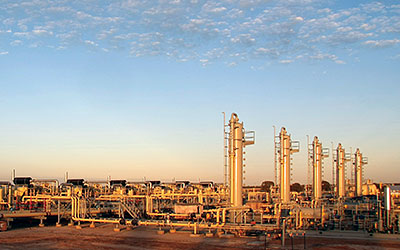Case History
Treating Low Flash Heavy Paraffinic Tank Bottoms In Situ for Recycling
Avoiding Risks and Maximizing Profit Recovering 6345 bbl.
CHALLENGE
Sludge of a 142-foot diameter tank with buildup of condensate of low flash point entrapped in
an emulsion.
SOLUTION
- Added Solvent-HW to distillate hydrotreater feed as cutter to dissolve and suspend tank bottoms.
- Circulation with two sweeps nozzles over several days breaks apart tank bottom emulsion.
- Centrifuge was used to remove solids and water (<1%).
RESULTS
Sludge treatment dissolved heel while centrifuge achieved water spec of <1%
Entire resolved material sent straight to FCC unit as profitable material, notexpensive waste.
Reclaiming 6345 bbl
Risk Removed
Tank sludge bottoms from Canadian crude sources have inherent issues in colder processing regions like the Midwest as the amount of condensate (dilbit) admixed to the heavier material to meet density specs while being able to be pumped through pipelines in colder months means the light fraction will vary. The lengthy time between turnarounds leads to a substantial tank heal heel.
CHEMICALS UTILIZED
Accumulation of waxy emulsion and low flashpoint condensate
The crude tank, operational for over a decade without interruption, faced issues due to the accumulation of condensate, a low flash point material. Originally used for storing Canadian crude, which inherently contains condensate, the tank experienced an increased proportion of condensate during the cold winter months in the upper Midwest refinery. The volatility observed mirrored a previous incident where a tank caught fire during manual cleaning. Recognizing the need to take the tank out of service, the conventional manned entry for cleaning posed a recurring risk. Dilution to meet pipeline specifications is crucial, as dilbit from the oil sands typically possesses an average API gravity of 21°.
Solution
Employing Solvent-HW enables the cutter to dissolve, disperse, and suspend the tank bottom, facilitating the effluent to undergo secondary processing with a centrifuge for phase separation. This cleaning technique proves more efficient and significantly safer. The centrifuge effectively removes solids and water, meeting the specification of less than 1%. Consequently, the treated effluent can be sent directly to the FCC unit for profit instead of incurring waste costs. Unlike heating the tank bottoms, which poses inherent risks, as the primary treatment variable,
the reliance on the cleaning power of Solvent-HW is the primary factor contributing to job success.
Managing Sludge with Advanced Treatment and Processing
The tank was de-inventoried revealing several feet of paraffin emulsion sludge. A hydrotreater feed cutter stock (flash point 147°F) was utilized along with Solvent-HW. Upon establishing the minimum liquid level, circulation commenced with heating to elevate the tank temperature, and a nitrogen generator reduced oxygen levels. Circulation persisted for a specified time, with the density of the circulating material serving as an indicator of effectiveness and endpoint. As the cutter solution’s density plateaued, the treatment was considered complete. The tank material was then directed to a secondary processing unit adjacent to the tank, involving a centrifuge and a second frac tank to ensure compliance with quality specifications before transfer to a holding tank. The objectives were successfully achieved, and the tank sludge was profitably fed directly into the FCC unit.
Mitigating Risks and Enhancing Cleaning Efficiency
Entering a storage tank with a low flash point for cleaning poses inherent danger and a high level of risk. Cleaning effectiveness is determined by four key parameters: temperature, mechanical energy, chemical energy, and the associated time factor. Given the significant ceiling on permissible temperature due to low flash point, the success of the cleaning operation heavily depended on the chemical energy provided by Solvent-HW. The remarkable capability of Solvent-HW facilitated the breakdown of sludge and the clearance of tank bottoms, even in areas typically challenging to reach (center of the tank). A thorough examination of the case involved the evaluation of nine different cutter stock possibilities, considering variations in concentration. This comprehensive analysis empowered the refinery to make an informed selection based on their preferences and an enhanced understanding of the mechanistic aspects.



